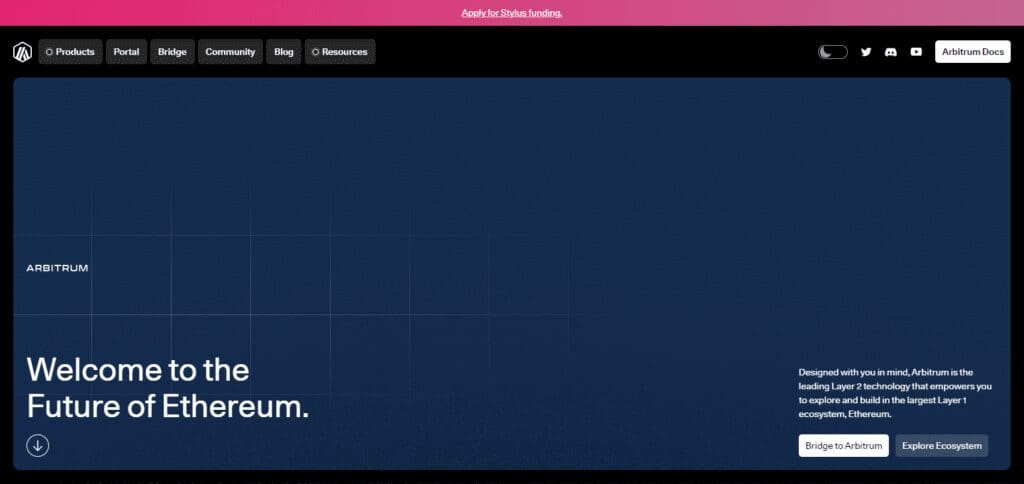In this article, I will discuss How to Bridge from Arbitrum to Blast, which is fairly simple as it allows users to transfer assets and tokens between Blockchains.
With just a few clicks, you can transfer your tokens from Arbitrum to Blast and enjoy the benefits of faster transaction times and lower costs. Let’s look into this procedure more closely.
What is Arbitrum?
Arbitrum is essentially a layer 2 scaling solution on the Ethereum blockchain. It targets the problems of scalability and transaction fees by conducting transactions outside of the Ethereum mainnet and posting the final results back to it.

This enables quicker and cheaper transactions at the cost of lower security than the Ethereum network.
The Arbitrum network uses Optimistic Rollups, which amalgamate and execute many transactions of the main net and only submit the state to the main net, which is the outcome of all the transactions.
How to Bridge from Arbitrum to Blast
Rhino.fi provides a quick and secure transfer platform that bridges assets from Arbitrum to Blast.

Currently, Rhino.fi has support for more than 17 Layer 1 and Layer 2 (including Ethereum, Solana, Arbitrum, Blast, and Base) and has transacted over $2 Billion in popular tokens (ETH, USDC, etc).
The Arbitrum to Blast bridging process goes like this:
To Open Rhino.fi: Launch Rhino.fi in your web browser and switch to the Arbitrum network on MetaMask to connect it.
Select Networks and Token: Choose Arbitrum as the source network and Blast as the target network. Select the transfer’s token, like ETH or USDC, etc.
Transfer Amount: Input the transfer’s amount and press ‘Approve’ in order for the transaction to be authorized from the metamask.
Transfer Completion: Complete the steps presented as a sequence of actions to transfer to finish. Depending on network congestion, your assets will be routed to Blast in a few minutes, max.
What Fees Can Be Expected?
Rhino.fi charges a fee of 0.19% when utilizing its services to send assets to Blast.
Although on-chain gas costs on Blast’s Layer 2, developed on the OP Stack, are generally less than one cent, shifting from the Ethereum mainnet into Blast could incur a gas expense of roughly $10.
On the other hand, Rhino.fi offers a more advantageous route because these figures are lower for smaller transfers and alternate solutions, such as Synapse, which can take up to 0.3% for every transfer and tend to have larger slippage.
Such an approach makes asset transfers more cost-effective and reliable, allowing for speedy and safe transactions at low costs.
Why Bridge to Blast? Understanding the Benefits
The advantages of bridging on Blast are that it is a blockchain network that aims to improve scalability and cross-chain communication and significantly reduce the cost of transactions.

Users who bridge their assets onto Blast can execute transactions faster and cheaper while taking advantage of more sophisticated features for DeFi and other blockchain applications developed on the Blast ecosystem.
1. Scalability and Speed
Enhanced scalability is one of the primary advantages of bridging on Blast. Blast has high throughput, which means more translations per second (TPS) than several other blockchains.
Since you can bring your assets for bridging, this means that since Blast is designed for DeFi transactions, such activities will have a speedy settlement.
2. Reduced Transaction Fees
The fees for transactions which have been processed on Blast Network are way lower than the fees that are charged when one is using the Ethereum blockchain or any other network that is always busy.
Bridging to Blast will enable users to escape the high gas fees prevalent at certain times, and still enjoy the high level of security and decentralization.
3. Interoperability Across Different Chains
Blast is built with users willing and able to bridge their assets not just from Ethereum alone but also from other blockchains.
Interoperability allows you to transfer your assets from Blast to several ecosystems and vice-versa, thus addressing a range of DeFi and dApps and multichain strategies.
4. The Entire Universe of Defi and dApps
After you bridge to Blast, you can access a suite of DeFi services such as staking, lending, borrowing and liquidity pools.
Gamification and NFT marketplaces are just some of the dApps the Blast’s ecosystem has available.
5. Censorship and Security Guarantee
With such advantages of speed and competitive fee markets, Blast offers high-security standards.
Network decision-making is dependably and realistically overseen by a constitutionally decentralized consensus vital for moving crypto assets across chains.
What is Blast?
Blast is an Ethereum Layer 2 solution that enables native yield on ETH and stablecoins.
It incorporates both ETH staking and on-chain T-Bill protocols, allowing Blast to offer a yield of 4% on ETH and 5% on stablecoins, much higher than on L2 platforms.

Being built on the OP Stack, Blast offers low transaction costs with support for auto-rebasing assets for simple integration with existing Dapps without changing user experience.
Alternative Arbitrum und Blast Bridge
Do you find Rhino.fi lacking for bridging transfers between Arbitrum and Blast? Here are some of the other ways to bridge:
Across Protocol
Across features an intent signalling infrastructure, which results in the fastest and the most cost-effective transfers on EVM-based layer 2 chains.
Stargate Finance
Best suited for transferring more significant amounts, especially stablecoins such as USDT and USDC. With deep liquidity and instant finality, Stargate is efficient for significant volume shifts between L2’s.
Synapse
Easy to use and safe, Synapse is stubbornly famous for being simple in cross-chain swaps, offering a bridge that works without safety issues. This is not to say that its fees are, on average, 0.2% higher than its rivals.
Conclusion
To conclude, bridging from Arbitrum to Blast is a straightforward procedure that expands the possibilities for greater scalability, lower costs and more varied blockchains.
By taking the proper steps to bridge your assets, Blast’s high-speed and low-cost network can be utilized while the great advantages of Arbitrum will still be held.










